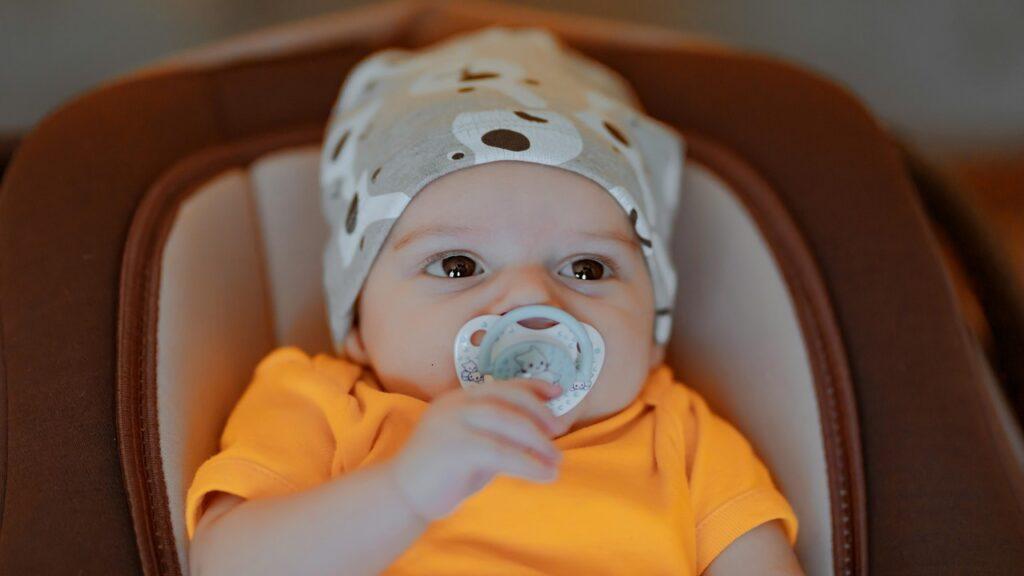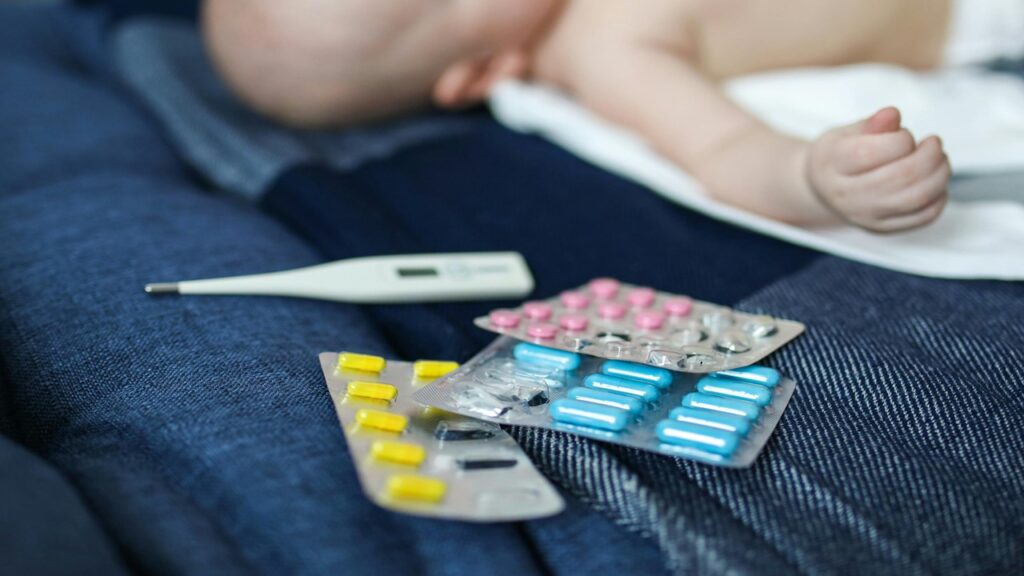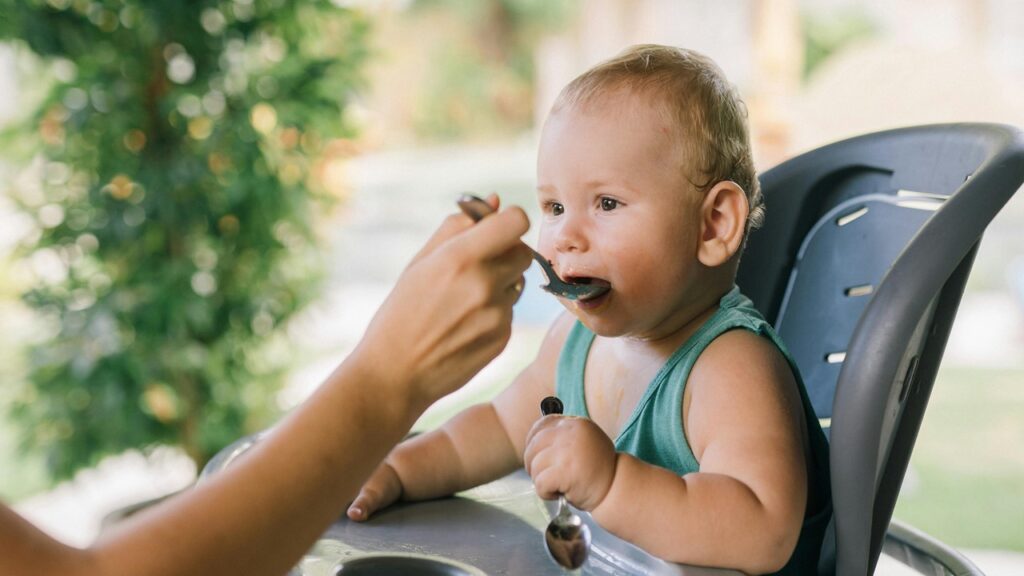
To keep a pacifier in a baby’s mouth, use a properly sized pacifier, gently hold it in place during sucking, and try a pacifier clip to keep it close. Make sure the baby is calm and not too hungry or fussy when offering it.
Keeping a pacifier in place can feel like a never-ending game of “drop and fetch,” right? We’ll talk about why pacifiers pop out, how to help your baby keep it in without frustration, and a few tips on safe pacifier use. We’ll also cover signs that it might be time to try other soothing methods if the pacifier just isn’t working out.
When to Introduce a Pacifier?
Introducing a pacifier can be a helpful tool for parents and a soothing comfort for babies. But when is the right time to start? Most pediatricians recommend waiting until breastfeeding is well established, typically around 3 to 4 weeks old. This waiting period helps ensure that the baby doesn’t develop nipple confusion, which can interfere with breastfeeding.
For bottle-fed babies, pacifiers can be introduced a bit earlier. The key is to observe your baby’s cues and comfort level. Introducing a pacifier too early can sometimes lead to confusion with feeding techniques, but waiting too long might make the baby less inclined to accept it. Each baby is unique, so paying attention to their specific needs and development is crucial.
Why Is It Hard for Babies to Hold Onto a Pacifier?
Babies have a natural sucking reflex, but maintaining a grip on a pacifier can be a challenge. Here are a few reasons why:
Developing Muscles
The muscles around the mouth and jaw are still developing in newborns. These muscles are crucial for sucking, but they aren’t fully formed, which makes it difficult for babies to keep the pacifier in place. As these muscles strengthen over time, babies will find it easier to hold onto the pacifier.
Size and Shape
If the pacifier is too big, too small, or not the right shape for your baby’s mouth, it might not stay in. Babies have different preferences when it comes to pacifiers, and finding the right fit can make a big difference. Some pacifiers are designed to mimic the shape of a mother’s nipple, which can be more comfortable for some babies.
Movement
Babies are naturally wiggly. Their constant movements can easily dislodge the pacifier. Whether they are moving their head, hands, or body, these motions can make it hard for the pacifier to stay put. Over time, as babies learn to control their movements better, keeping a pacifier in their mouth becomes easier.
Tips to Keep a Pacifier in Your Baby’s Mouth
Ensuring that a pacifier stays in your baby’s mouth can be a bit tricky, but these tips can help:
Choose the Right Pacifier
Finding the right pacifier for your baby is crucial. Look for one that matches their age and stage of development. The nipple shape, size, and material can make a big difference. Some babies prefer a specific type, so don’t be afraid to try a few different options.
For newborns, pacifiers with a smaller, softer nipple are often the best choice. As your baby grows, you may need to switch to a larger size. Silicone pacifiers are generally more durable, while latex pacifiers are softer and more flexible. Pay attention to the age recommendations on the packaging and consult with your pediatrician if you’re unsure.
Proper Positioning
When offering the pacifier, gently place it in your baby’s mouth and ensure it’s well-seated. Sometimes a slight twist can help it stay in better. Make sure your baby is calm and not overly excited or fussy when introducing the pacifier.
If your baby seems to be pushing the pacifier out with their tongue, try waiting until they are a bit more relaxed. Offering the pacifier during quiet, calm moments can help them accept it more readily. Additionally, make sure your baby is positioned comfortably, with their head slightly elevated, which can help keep the pacifier in place.
Encourage Sucking
Help your baby get used to the pacifier by encouraging them to suck on it. You can do this by gently holding it in place for a few moments until they get a good grip. Avoid forcing it, as this can create negative associations.
If your baby is resistant, try dipping the pacifier in breast milk or formula to make it more appealing. The familiar taste can encourage them to start sucking. Once they get the hang of it, they will be more likely to keep the pacifier in their mouth on their own.
Use Pacifier Clips
Pacifier clips can be a lifesaver. They attach the pacifier to your baby’s clothing, ensuring it doesn’t fall on the floor if it gets spit out. This also makes it easier for your baby to find and reinsert the pacifier themselves.
When choosing a pacifier clip, make sure it is safe and complies with safety standards. The clip should be short enough to prevent strangulation risks but long enough for your baby to move their head comfortably. Always supervise your baby when using a pacifier clip to avoid any accidents.
Be Patient
It might take a little time for your baby to get used to the pacifier. Be patient and keep trying. Sometimes, it’s a matter of timing and practice. Each baby is different, and what works for one might not work for another.
Try offering the pacifier at different times of the day and in various situations. Some babies prefer it when they are sleepy, while others might take to it better when they are wide awake. Consistency is key, so keep offering the pacifier regularly until your baby gets used to it.
Monitor Pacifier Condition
Regularly check the pacifier for wear and tear. A damaged pacifier can be harder to keep in the mouth and may pose a safety risk. Replace pacifiers as needed to ensure they are in good condition.
Inspect the pacifier daily for signs of cracking, tearing, or weakening. If you notice any damage, discard the pacifier immediately and replace it with a new one. Keeping a few spare pacifiers on hand can be helpful, so you always have a backup.
How Pacifiers Help Ease Parents’ Lives: Benefits of a Pacifier
Pacifiers can be a game-changer for both babies and parents. They offer numerous benefits that can significantly ease the challenges of early parenthood. Here’s a closer look at how pacifiers can help make parents’ lives a little bit easier.
Instant Soothing for Fussy Babies
One of the most immediate benefits of a pacifier is its ability to soothe a fussy baby almost instantly. Babies have a natural sucking reflex, and a pacifier can help satisfy this need when they are not hungry. This can be especially helpful in public places or during activities where crying might be disruptive. With a pacifier, parents can quickly calm their baby, reducing stress for everyone involved.
Sleep Aid for Better Rest
Pacifiers can be a lifesaver when it comes to helping babies fall asleep. The sucking motion is calming and can help babies drift off to sleep more easily. This means fewer sleepless nights for parents, as a content and soothed baby is more likely to sleep longer and more peacefully. More rest for the baby often translates to more rest for the parents, helping them stay energized and better able to handle the demands of parenting.
Reducing the Risk of SIDS
Studies have shown that using a pacifier during naps and bedtime can reduce the risk of sudden infant death syndrome (SIDS). Knowing that your baby is safer with a pacifier can provide peace of mind for parents, allowing them to relax more and worry less about their baby’s safety during sleep.
Helping with Feeding Schedules
Pacifiers can help manage feeding schedules by satisfying the baby’s need to suck without offering food. This can be particularly useful for parents trying to establish a routine, as the pacifier can be used to comfort the baby between feedings. This helps prevent overfeeding and gives parents a bit more control over feeding times.
Alleviating Minor Discomforts
Whether it’s teething pain or the discomfort from a vaccination, sucking on a pacifier can provide some relief for babies. This can save parents from the stress of dealing with a crying, uncomfortable baby. Pacifiers designed for teething can be especially helpful, providing a safe object for babies to chew on and relieve their gum pain.
Convenience in Public and Travel
Having a pacifier on hand can be incredibly convenient when you’re out and about. Whether you’re shopping, traveling, or visiting friends, a pacifier can quickly soothe your baby, making outings more enjoyable and less stressful. It’s a portable solution that can help manage your baby’s mood and keep them calm in new environments.
Easing Transitions
Pacifiers can help ease various transitions that might otherwise be difficult for babies, such as moving from breast to bottle, starting daycare, or adjusting to new sleeping arrangements. The familiar comfort of a pacifier can make these changes less stressful for the baby, and by extension, easier for the parents.
Encouraging Independence
As babies grow older, they can learn to self-soothe with their pacifiers, which can help them develop a sense of independence. This can be a huge relief for parents, as it means their child is learning to manage their own comfort and emotions without constant intervention. It’s a small step towards greater self-reliance and can make parenting a bit less demanding.
Actions to Avoid
While pacifiers can be incredibly helpful, there are certain actions you should avoid ensuring your baby’s safety and comfort:
Avoid Force-Feeding
Never force a pacifier into your baby’s mouth. This can create a negative experience and may make them resistant to using it in the future. Instead, gently offer it and let your baby take it at their own pace.
Forcing a pacifier can lead to stress and discomfort for your baby. It’s important to respect their preferences and let them decide if they want to use it. If they consistently refuse the pacifier, it might not be the right soothing method for them.
Avoid Sweetening the Pacifier
Dipping the pacifier in honey, sugar, or other sweet substances is a bad idea. This can lead to tooth decay and other health issues. It’s important to keep the pacifier clean and free from harmful substances.
Babies under one-year-old should never be given honey due to the risk of botulism. Even older babies should avoid sweetened pacifiers, as it can encourage unhealthy eating habits and contribute to dental problems later on. If you want to make the pacifier more appealing, try dipping it in breast milk or formula instead.
Avoid Over-Reliance
While pacifiers can be great for soothing, they shouldn’t be the only method used. Over-reliance on pacifiers can interfere with speech development and create dependency. Balance pacifier use with other soothing techniques like cuddling, singing, or rocking.
Using a variety of soothing methods helps your baby develop a range of coping skills. It also prevents them from becoming overly attached to the pacifier, which can be challenging to wean later on. Encourage your baby to find comfort in different ways, and use the pacifier as just one tool in your soothing toolkit.
Avoid Prolonged Use
As your baby grows, try to gradually reduce pacifier use. Prolonged use, especially beyond the age of two, can lead to dental issues such as misaligned teeth. Start weaning your baby off the pacifier as they approach their first birthday.
Weaning from the pacifier can be a gradual process. Start by limiting pacifier use to nap times and bedtime, and then gradually phase it out completely. Offer other forms of comfort and distraction, such as favorite toys or activities, to help ease the transition.
Takeaway
So, dealing with pacifiers can be a bit of a puzzle, but don’t worry, it’s not too hard! Every baby is different, so you need to try different things to see what works. Pick a pacifier that fits your baby, put it in the right way, and use clips to help keep it from falling out.
Just remember not to force it into their mouth or dip it in sweet stuff. Check it often to make sure it’s not broken. With these simple tricks, pacifiers can help keep your baby calm and happy. Parenting is all about figuring out what your baby likes best. Keep trying new things and stay patient. Before you know it, you’ll have a happier, more peaceful baby. Good luck!
Related FAQs
1. What age is best to introduce a pacifier?
It’s best to introduce a pacifier around 3 to 4 weeks old for breastfed babies, once breastfeeding is well established.
2. How can I help my baby keep the pacifier in their mouth?
Ensure the pacifier is the right size and shape, and gently hold it in place while encouraging sucking. Pacifier clips can also help.
3. Is it safe to use a pacifier at night?
Yes, using a pacifier at night can help reduce the risk of SIDS. Just ensure the pacifier is clean and in good condition.
4. How often should I replace my baby’s pacifier?
Regularly check for signs of wear and tear and replace pacifiers as needed, typically every 1 to 2 months.
5. Can pacifiers cause dental problems?
Prolonged use of pacifiers can lead to dental issues. It’s best to start weaning your baby off the pacifier by age two to avoid problems.
Hi, I’m the voice behind BabyNush — a lover of all things baby, with years of hands-on experience caring for kids and little ones in my life. Growing up around babies taught me the ins and outs of childcare, and now I’m here to share practical tips, how-to guides, and reviews to help make your parenting journey smoother.










